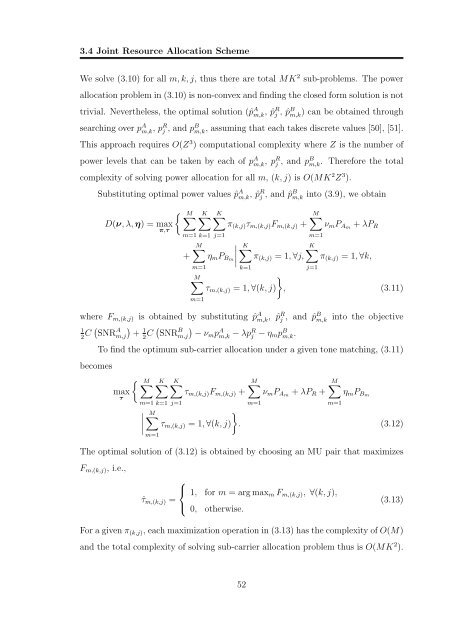Resource Allocation in OFDM Based Wireless Relay Networks ...
Resource Allocation in OFDM Based Wireless Relay Networks ...
Resource Allocation in OFDM Based Wireless Relay Networks ...
Create successful ePaper yourself
Turn your PDF publications into a flip-book with our unique Google optimized e-Paper software.
3.4 Jo<strong>in</strong>t <strong>Resource</strong> <strong>Allocation</strong> Scheme<br />
We solve (3.10) for all m, k, j, thus there are total MK 2 sub-problems. The power<br />
allocation problem <strong>in</strong> (3.10) is non-convex and f<strong>in</strong>d<strong>in</strong>g the closed form solution is not<br />
trivial. Nevertheless, the optimal solution (ˆp A m,k , ˆpR j , ˆp B m,k ) can be obta<strong>in</strong>ed through<br />
search<strong>in</strong>g over p A m,k , pR j , and p B m,k , assum<strong>in</strong>g that each takes discrete values [50], [51].<br />
This approach requires O(Z 3 ) computational complexity where Z is the number of<br />
power levels that can be taken by each of p A m,k , pR j , and p B m,k . Therefore the total<br />
complexity of solv<strong>in</strong>g power allocation for all m, (k, j) is O(MK 2 Z 3 ).<br />
Substitut<strong>in</strong>g optimal power values ˆp A m,k , ˆpR j , and ˆp B m,k<br />
{<br />
∑ M K∑ K∑<br />
D(ν, λ, η) = max<br />
π (k,j) τ m,(k,j) F m,(k,j) +<br />
π,τ<br />
m=1 k=1 j=1<br />
M∑<br />
∣ ∣∣∣ ∑ K<br />
+ η m P Bm π (k,j) = 1, ∀j,<br />
m=1<br />
k=1<br />
<strong>in</strong>to (3.9), we obta<strong>in</strong><br />
M∑<br />
ν m P Am + λP R<br />
m=1<br />
K∑<br />
π (k,j) = 1, ∀k,<br />
j=1<br />
M∑<br />
}<br />
τ m,(k,j) = 1, ∀(k, j) , (3.11)<br />
m=1<br />
where F m,(k,j) is obta<strong>in</strong>ed by substitut<strong>in</strong>g ˆp A m,k , ˆpR j , and ˆp B m,k<br />
1<br />
C ( )<br />
SNR A 2 m,j +<br />
1<br />
C ( SNR B 2 m,j)<br />
− νm p A m,k − λpR j − η m p B m,k .<br />
becomes<br />
<strong>in</strong>to the objective<br />
To f<strong>in</strong>d the optimum sub-carrier allocation under a given tone match<strong>in</strong>g, (3.11)<br />
{<br />
∑ M K∑ K∑<br />
M∑<br />
M∑<br />
max<br />
τ m,(k,j) F m,(k,j) + ν m P Am + λP R + η m P Bm<br />
τ<br />
m=1 k=1 j=1<br />
m=1<br />
m=1<br />
M∑<br />
}<br />
∣ τ m,(k,j) = 1, ∀(k, j) . (3.12)<br />
m=1<br />
The optimal solution of (3.12) is obta<strong>in</strong>ed by choos<strong>in</strong>g an MU pair that maximizes<br />
F m,(k,j) , i.e.,<br />
⎧<br />
⎨ 1, for m = arg max m F m,(k,j) , ∀(k, j),<br />
ˆτ m,(k,j) =<br />
⎩ 0, otherwise.<br />
(3.13)<br />
For a given π (k,j) , each maximization operation <strong>in</strong> (3.13) has the complexity of O(M)<br />
and the total complexity of solv<strong>in</strong>g sub-carrier allocation problem thus is O(MK 2 ).<br />
52

















